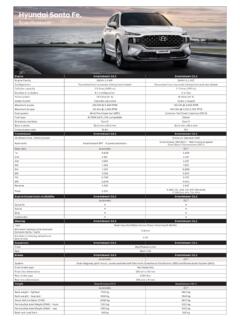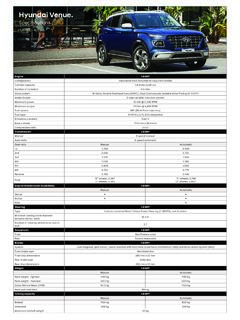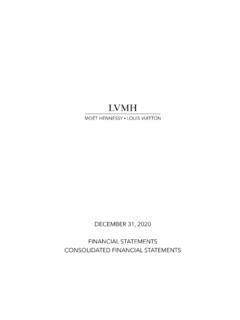Transcription of HYUNDAI MOTOR COMPANY AND ITS SUBSIDIARIES
1 HYUNDAI MOTOR COMPANY AND ITS SUBSIDIARIES consolidated FINANCIAL STATEMENTS AS OF AND FOR THE YEARS ENDED December 31, 2020 AND 2019 ATTACHMENT: INDEPENDENT AUDITORS REPORT HYUNDAI MOTOR COMPANY Contents INDEPENDENT AUDITORS REPORT ---------------------------------------- ------------------- 1 consolidated FINANCIAL STATEMENTS consolidated STATEMENTS OF FINANCIAL POSITION ----------------------------------- 6 consolidated STATEMENTS OF income ---------------------------------------- -------------- 8 consolidated STATEMENTS OF comprehensive income --------------------------- 9 consolidated STATEMENTS OF CHANGES IN EQUITY ------------------------------------ 10 consolidated STATEMENTS OF CASH FLOWS ---------------------------------------- ------- 12 NOTES TO THE consolidated FINANCIAL STATEMENTS --------------------------------- 14 152, Teheran-ro, Gangnam-gu, Seoul 06236(Yeoksam-dong, Gangnam Finance Center 27th Floor)
2 Republic of KoreaIndependent Auditors Report Based on a report originally issued in Korean To the Board of Directors and Shareholders HYUNDAI MOTOR COMPANY : Opinion We have audited the consolidated financial statements of HYUNDAI MOTOR COMPANY and its SUBSIDIARIES ( the Group ), which comprise the consolidated statement of financial position as of December 31, 2020 and 2019, the consolidated statements of income , comprehensive income , changes in equity and cash flows for the years then ended, and notes, comprising significant accounting policies and other explanatory information. In our opinion, the accompanying consolidated financial statements present fairly, in all material respects, the consolidated financial position of the Group as of December 31, 2020 and 2019, and its consolidated financial performance and its consolidated cash flows for the years then ended in accordance with Korean International Financial Reporting Standards ( K-IFRS ).
3 Basis for Opinion We conducted our audit in accordance with Korean Standards on Auditing (KSAs). Our responsibilities under those standards are further described in the Auditors Responsibilities for the Audit of the consolidated Financial Statements section of our report. We are independent of the Group in accordance with the ethical requirements that are relevant to our audit of the consolidated financial statements in Republic of Korea, and we have fulfilled our other ethical responsibilities in accordance with these requirements. We believe that the audit evidence we have obtained is sufficient and appropriate to provide a basis for our opinion. Key Audit Matters Key audit matters are those matters that, in our professional judgment, were of most significance in our audit of the consolidated financial statements as of and for the year ended December 31, 2020.
4 These matters were addressed in the context of our audit of the consolidated financial statements as a whole, and in forming our opinion thereon, and we do not provide a separate opinion on these matters 1) Warranty provisions As described in Note 2 (20) and Note 17 to the consolidated financial statements, the Group recognized warranty provision in the amount of 8,514,173 million as of December 31, 2020. The Group provides customers with free warranty services for guaranteed period and free repair services in the event of recall and campaign. The Group aggregates sales volume by vehicle model and estimates warranty expenses which are expected to be incurred based on historical data of the actual warranty costs. Warranty provisions are measured at the present value based on the expected expenditure of warranty costs and discount rates. In order to measure and recognize warranty provisions, management applies assumptions to estimate expected warranty cost per unit by vehicle model and expected number of repair cases and applies discount rates to measure the present value of provisions.
5 Management uses historical data of the actual warranty costs to estimate expected warranty cost per unit by vehicle model and expected number of repair cases. We determined the valuation of warranty provision as a key audit matter because errors in aggregation of actual warranty costs and sales volume by vehicle models and in assumptions used to estimate future warranty expenses and discount rates would have a significant impact on the consolidated financial statements. ssssssssssssssssssssssssssss2 The primary procedures we performed to address this key audit matter included the following: -Understanding of the process to measure and recognize warranty provisions and testing of relevant controls. -Testing of completeness and accuracy of vehicles sold used for estimation through inspection of related documents. -Evaluating reasonableness of assumptions applied for expected warranty cost per unit by vehicle model by comparing warranty expenses incurred in the current period to expected warranty expenses in the prior period.
6 -Evaluating reasonableness of assumptions applied for expected number of repair cases based on historical data analysis. -Testing of accuracy of warranty provision balance by inspecting documents related to historical data of the actual warranty expenses on a sample basis and testing of recalculation. -Testing of appropriateness of discount rates by comparing to external sources of information. 2)Valuation of financial services receivables As described in Note 2.(8) and Note 14 to the consolidated financial statements, the Group recognized financial services receivables and loss allowance in the amount of 69,665,210 million and 1,685,229 million as of December 31, 2020, respectively. The Group recognizes allowance for credit loss using the expected credit loss (ECL) model for financial services receivables in accordance with K-IFRS 1109 financial instruments.
7 Judgment of the management is required to determine whether the receivable has experienced a significant increase in credit risk and other assumptions applied to the ECL model, including credit rating and macroeconomic variables. In addition, the Group uses historical transaction data such as overdue, bankruptcy and collection in determining assumptions used in the ECL model. Since the impact on the consolidated financial statements due to errors in the assumptions applied to the ECL model is significant, we determined that valuation of financial services receivables is a key audit matter. The primary procedures we performed to address this key audit matter included the following: -Assessing whether the Group s accounting policies comply with the requirements in K-IFRS 1109 Financial Instruments . -Understanding of the process over the measurement of credit loss allowance on financial services receivables and testing of relevant controls.
8 -On a sample basis, assessing the credit rating and classification of credit quality including the identification of significant increase credit risk, through inspection of related documents. -On a sample basis, checking the source data for probability of default and loss given default and testing of appropriateness of calculation methods used for the estimation through recalculation. Other matter The procedures and practices utilized in the Republic of Korea to audit such consolidated financial statements may differ from those generally accepted and applied in other countries. Responsibilities of Management and Those Charged with Governance for the ConsolidatedFinancial Statements Management is responsible for the preparation and fair presentation of the consolidated financial statements in accordance with K-IFRS, and for such internal control as management determines is necessary to enable the preparation of consolidated financial statements that are free from material misstatement, whether due to fraud or error.
9 In preparing the consolidated financial statements, management is responsible for assessing the Group s ability to continue as a going concern, disclosing, as applicable, matters related to going concern and using the going concern basis of accounting unless management either intends to liquidate the Group or to cease operations, or has no realistic alternative but to do so. Those charged with governance are responsible for overseeing the Group s financial reporting process. ssssssssssssssssssssssssssss3 Auditors Responsibilities for the Audit of the consolidated Financial Statements Our objectives are to obtain reasonable assurance about whether the consolidated financial statements as a whole are free from material misstatement, whether due to fraud or error, and to issue an auditors report that includes our opinion. Reasonable assurance is a high level of assurance, but is not a guarantee that an audit conducted in accordance with KSAs will always detect a material misstatement when it exists.
10 Misstatements can arise from fraud or error and are considered material if, individually or in the aggregate, they could reasonably be expected to influence the economic decisions of users taken on the basis of these consolidated financial statements. As part of an audit in accordance with KSAs, we exercise professional judgment and maintain professional skepticism throughout the audit. We also: Identify and assess the risks of material misstatement of the consolidated financial statements, whether due to fraud or error, design and perform audit procedures responsive to those risks, and obtain audit evidence that is sufficient and appropriate to provide a basis for our opinion. The risk of not detecting a material misstatement resulting from fraud is higher than for one resulting from error, as fraud may involve collusion, forgery, intentional omissions, misrepresentations, or the override of internal control.

















